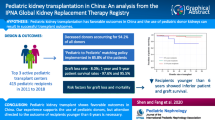Abstract
Kidney transplantation is the treatment of choice for children with end-stage renal disease. In Iran, a kidney transplantation program was started in the Labfi Nejad Hospital, Tehran in 1985. From 1985 to 2003, 278 children (mean age 11.6 years, 59.7% males) received their first renal transplant. All transplants were donations from live donors (12.5% live-related donors); 30.8% of patients were preemptively transplanted. The overall 1-year patient survival rate was 92% and the 5-year survival rate 74%. The median graft survival time was 7.2 years. The rate of graft survival was 88.8% at 1 year, 77% at 3 years, 67% at 5 years, 50% at 7 years, and 43% at 10 years after transplantation. The survival rate of patients and transplants improved significantly with time (p<0.05). In patients transplanted before 1997, the 5-year graft survival was 50% and 82% in patients transplanted after 1997. At the same time intervals, the frequency of acute rejection episodes was 66.6 versus 40.8% and of chronic rejection 50.5 versus 28.7%. The outcome in children below the age of 6 years was poor. Graft survival was negatively correlated with the frequency and an early time point of acute rejection episodes. The modus of transplantation (preemptive or postdialysis) did not influence the results. In conclusion, patient and graft survival in transplanted children significantly improved with time, thus reflecting greater medical and surgical experience, new immunosuppressive drugs, and better compliance.



Similar content being viewed by others
References
Kohaut EC (1999) End stage renal disease, Chap. 325. In: McMillan JA, Deangelis CD, Feigin RD, Warshaw JB, Oski FA (eds) Oski’s pediatrics: principles and practice, 3rd edn. Mosby, Pennsylvania, p 1572
Johnson RJ, Armstrong S, Belger MA, Fuggle SV, Martin S, Middleton D, Ray TC, Rigden SP, Verrier-Jones K, Morris PJ, Paediatric Task Force of United Kingdom Transplant, Bristol, UK (2002) The outcome of pediatric cadaveric renal transplantation in the UK and Eire. Pediatr Transplant 6:367–377
Seikaly M, Ho PL, Emmett L, Tejani A (2001) The 12th Annual Report of the North American Pediatric Renal Transplant Cooperative Study: renal transplantation from 1987 through 1998. Pediatr Transplant 5:215–231
North American Pediatric Renal Transplant Cooperative Study (NAPRTCS) (2003) Annual report: renal transplantation, dialysis, chronic renal insufficiency. EMMES, Rockville, MD
al-Akash SI, Ettenger RB (2005) Kidney transplantation in children, Chap. 15. In: Danovich GM (ed) Handbook of kidney transplantation, 4th edn. Lippincott Williams & Wilkins, Baltimore, p 414
IR Iran Parliament (2000) Deceased or brain dead patients organ transplantation act. H/24804-T/9929, 4 June
Broumand B (2005) Transplantation activities in Iran. Exp Clin Transplant 3:333–337
Banowsky LH (1983) Current results and future expectations in renal transplantation. Urol Clin North Am 10:337–346
Ting A, Morris PJ (1978) Matching for B-cell antigens of the HLA-DR series in cadaver renal transplantation. Lancet 1:575–577
Dickenmann MJ, Nickeleit V, Tsinalis D, Gürke L, Mihatsch MJ, Thiel G (2002) Why do kidney grafts fail? A long-term single-center experience. Transpl Int 15:508–514
Tejani A, Cortes L, Stablein D (1996) Clinical correlates of chronic rejection in pediatric renal transplantation. A report of the North American Pediatric Renal Transplant Cooperative Study. Transplantation 61:1054–1058
Girndt M, Sester M, Sester U, Kaul H, Kohler H (2001) Molecular aspects of T- and B-cell function in uremia. Kidney Int Suppl 78:S206–S211
Kasiske BL, Snyder JJ, Matas AJ, Ellison MD, Gill JS, Kausz AT (2002) Preemptive kidney transplantation: the advantage and the advantaged. J Am Soc Nephrol 13:1358–1364
Nevins TE, Danielson G (1991) Prior dialysis does not affect the outcome of pediatric renal transplantation. Pediatr Nephrol 5:211–214
Flom LS, Reisman EM, Donovan JM, Zaontz MR, Stein J, Firlit CF, Cohn RA (1992) Favorable experience with pre-emptive renal transplantation in children. Pediatr Nephrol 6:258–261
Katz SM, Kerman RH, Golden D, Grevel J, Camel S, Lewis RM, Van Buren CT, Kahan BD (1991) Preemptive transplantation—an analysis of benefits and hazards in 85 cases. Transplantation 51:351–355
Offner G, Hoyer PF, Meyer B, Pichlmayr R, Brodehl J (1993) Preemptive renal transplantation in children and adolescents. Transpl Int 6:125–128
Mahmoud A, Said MH, Dawahra M, Hadj-Aissa A, Schell M, Faraj G, Long D, Parchoux B, Martin X, Cochat P (1997) Outcome of preemptive renal transplantation and pre-transplantation dialysis in children. Pediatr Nephrol 11:537–541
John AG, Rao M, Jacob CK (1998) Preemptive live-related renal transplantation. Transplantation 66:204–209
Ishitani M, Isaacs R, Norwood V, Nock S, Lobo P (2000) Predictors of graft survival in pediatric living-related kidney transplant recipients. Transplantation 70:288–292
Roake JA, Cahill AP, Gray CM, Gray DW, Morris PJ (1996) Preemptive cadaveric renal transplantation—clinical outcome. Transplantation 62:1411–1416
Asderakis A, Augustine T, Dyer P, Short C, Campbell B, Parrott NR, Johnson RW (1998) Preemptive kidney transplantation: the attractive alternative. Nephrol Dial Transplant 13:1799–1803
Papalois VE, Moss A, Gillingham KJ, Sutherland DE, Matas AJ, Humar A (2000) Pre-emptive transplants for patients with renal failure: an argument against waiting until dialysis. Transplantation 70:625–631
Vats AN, Donaldson L, Fine RN, Chavers BM (2000) Pre-transplant dialysis status and outcome of renal transplantation in North American children: a NAPRTCS Study. North American Pediatric Renal Transplant Cooperative Study. Transplantation 69:1414–1419
Author information
Authors and Affiliations
Corresponding author
Rights and permissions
About this article
Cite this article
Otukesh, H., Basiri, A., Simfrosh, N. et al. Outcome of pediatric renal transplantation in Labfi Nejad Hospital, Tehran, Iran. Pediatr Nephrol 21, 1459–1463 (2006). https://doi.org/10.1007/s00467-006-0184-5
Received:
Revised:
Accepted:
Published:
Issue Date:
DOI: https://doi.org/10.1007/s00467-006-0184-5



